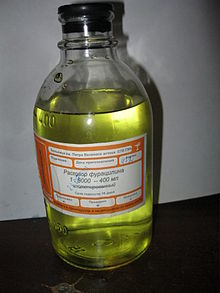Nitrofurazone
 | |
 | |
| Clinical data | |
|---|---|
| AHFS/Drugs.com | Micromedex Detailed Consumer Information |
| ATC code | |
| Identifiers | |
| |
| CAS Number | |
| PubChem CID | |
| DrugBank | |
| ChemSpider | |
| UNII | |
| KEGG | |
| ChEBI | |
| ChEMBL | |
| CompTox Dashboard (EPA) | |
| ECHA InfoCard | 100.000.403 |
| Chemical and physical data | |
| Formula | C6H6N4O4 |
| Molar mass | 198.14 g/mol g·mol−1 |
| 3D model (JSmol) | |
| |
| |
| | |
Nitrofural (INN, trade name Furacin) is a bactericidal compound used as an antibiotic most commonly in the form of ointments. Its use in medicine has become less frequent as safer and more effective products have become available[citation needed], and it has been discontinued in the US.[1] The substance is pale yellow and crystalline.
Other names include nitrofurazone and furacilin.

References
- ^ Drugs.com: Nitrofurazone (Topical route)
